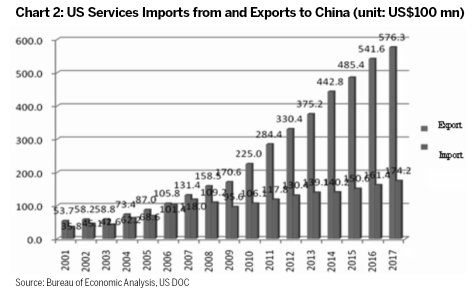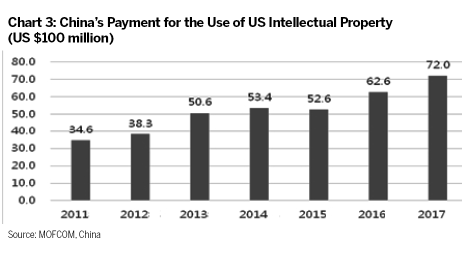The facts and China's position on China-US trade friction
China Daily | Updated: 2018-09-26 08:00
2. Bilateral trade in services is developing quickly.
The US has a highly-advanced and fully-fledged service industry which is very competitive on the international market. Accompanying the growth of the Chinese economy and the improvement of Chinese people's living standards is an obvious rise in demand for services and rapid growth in bilateral services trade. According to US statistics, two-way trade in services rose from US$24.94 billion in 2007 to US$75.05 billion in 2017. According to MOFCOM, the US was China's second biggest services trade partner; according to USDOC, China is the third biggest market for US service exports.
The US is the biggest source of China's deficit in services trade and this deficit has been increasing fast. US statistics show that US service exports to China grew 340% from US$13.14 billion in 2007 to US$57.63 billion in 2017 while its service exports to other countries and regions in the same period grew by 180%. The US surplus with China in services multiplied by a factor of 30 to US 40.2 billion. (Chart 2) At present, the US represents roughly 20% of China's total deficit in services trade, the biggest source of this deficit. China's deficit with the US is concentrated in three areas, travel, transport and intellectual property royalties.

China's trade deficit with the US in tourism continues to widen. According to the DOC, by 2016 the number of Chinese mainland visitors to the US had been increasing for 13 consecutive years, with double-digit growth in 12 of the 13 years. MOFCOM statistics suggest that in 2017 Chinese visitors going to the US for tourism, education, and medical treatment spent a total of US$51 billion in the US. Among them, 3 million were tourists, who spent as much as US$33 billion while traveling in the US. In education, the US is the largest overseas destination for Chinese students. In 2017, there were around 420,000 Chinese students in the US, contributing some US$18 billion to local revenues. According to US figures, China's trade deficit with the US in tourism grew from US$430 million in 2006 to US$26.2 billion in 2016, registering an average annual growth of 50.8%.
China's payments for the use of US intellectual property continues to rise. Chinese statistics indicate that the US is the largest source of intellectual property imports to China. From 2012 to 2016, China imported nearly 28,000 items of intellectual property from the US. China's payments for US intellectual property doubled in six years from US$3.46 billion in 2011 to US$7.2 billion in 2017.(Chart 3) In breakdown, China's intellectual property payments to the US accounted for a quarter of its total intellectual property payments to foreign countries.

3. China and the US are important investment partners.
The US is a major source of foreign investment for China. According to MOFCOM, by the end of 2017, there were approximately 68,000 US-funded enterprises in China with over US$83 billion in actualized investment. With a rapid increase in direct investment by Chinese enterprises in the US, the latter has become an important destination for Chinese investment. As China's outbound investment grew, Chinese enterprises' direct investment in the US rose from US$65 million in 2003 to US$16.98 billion in 2016. According to MOFCOM figures, by the end 2017, the stock of Chinese direct investment in the US amounted to approximately US$67 billion. Meanwhile, China has also made a significant financial investment in the US. According to the US Treasury Department, China held US$1.18 trillion of US treasury bills by the end of May 2018.
























